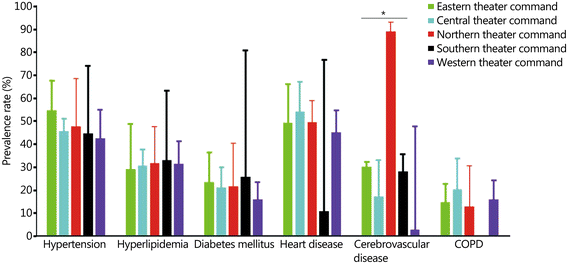The prevalence rates of major chronic diseases in retired and in-service Chinese military officers (2000-2016): a meta-analysis
- PMID: 29502533
- PMCID: PMC5789691
- DOI: 10.1186/s40779-017-0148-z
The prevalence rates of major chronic diseases in retired and in-service Chinese military officers (2000-2016): a meta-analysis
Abstract
Background: Chronic diseases cause a tremendous burden to the military medical system. However, the prevalence rates of major chronic diseases among military officers remain unclear in China.
Methods: China National Knowledge Infrastructure (CNKI), Wanfang Database, VIP Database for Chinese Technical Periodicals (VIP), PubMed and Web of Science were searched for studies (from 2000 to 2016) concerning 6 major chronic diseases: hypertension, hyperlipidemia, diabetes mellitus, heart diseases, cerebrovascular diseases, and chronic obstructive pulmonary diseases (COPD) in Chinese military officers following strict inclusion and exclusion criteria. Three researchers independently extracted data from the included studies, and a fourth researcher reviewed and solved every disagreement. Statistical analysis was performed with STATA 14.0 and R 3.3.2. Heterogeneity was evaluated by the I 2 value. A random effect model was performed to combine the heterogeneous data. The Egger test was performed to test the publication bias.
Results: A total of 90,758 military officers derived from 75 articles were pooled together. Publication bias was only observed in 37 studies reporting heart disease (P Egger test = 0.01). The overall prevalence rates of hypertension, hyperlipidemia, diabetes mellitus, heart diseases, cerebrovascular diseases, and COPD were 46.6% (95% CI 41.8-51.5%), 30.9% (26.4-35.7%), 20.7% (16.5-25.7%), 48.2% (41.7-54.9%), 20.2% (14.8-26.9%) and 16.6% (12.9-21.0%), respectively. The prevalence rates of hypertension, diabetes, heart disease, cerebrovascular disease, and COPD, rather than hyperlipidemia, increased with age in Chinese military officers. Heart diseases (P Q-test < 0.001) and hypertension (P Q-test < 0.001) increased sharply in retired officers compared with officers in service. Cerebrovascular disease was more frequent in Northern Theater Command than in any other theater command (P Q-test < 0.001).
Conclusions: Major chronic diseases heavily affect Chinese military officers, especially retirees. Medical intervention should be enforced on the prevention of cerebrovascular diseases in those working in cold areas in the north, as well as hypertension and heart diseases in retirees.
Keywords: Cerebrovascular disease; Chronic diseases; Chronic obstructive pulmonary disease; Diabetes; Hyperlipidemia; Hypertension; Meta-analysis.
Conflict of interest statement
Ethics approval and consent to participate
Not applicable.
Consent for publication
Not applicable.
Competing interests
The authors declare that they have no competing interests.
Figures





References
Publication types
MeSH terms
Grants and funding
LinkOut - more resources
Full Text Sources
Other Literature Sources
Medical

